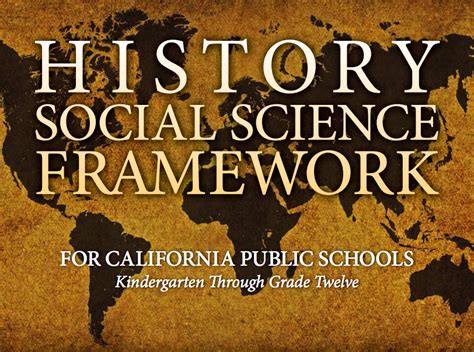Introduction: The Significance of California History-Social Science Standards

California’s History-Social Science Framework provides a set of rigorous and comprehensive standards that guide the teaching and learning of history and social sciences in the state’s K-12 schools. These standards play a pivotal role in shaping what students learn and how they develop critical thinking, problem-solving, and civic engagement skills essential for their success as informed citizens.
Core Concepts and Standards
The California History-Social Science Framework is organized around six core strands:
- History and Geography
- Civics and Government
- Economics and Personal Finance
- Sociology
- Geography
- History of California
Each strand is further divided into grade-level standards, which specify the knowledge and skills students should acquire by the end of each grade. The standards span various historical epochs, geographical regions, and social issues.
Essential Skills and Abilities
In addition to content knowledge, the framework emphasizes the development of essential skills and abilities, including:
- Historical Thinking Skills: Analyzing, interpreting, and evaluating historical events, sources, and perspectives.
- Geographic Reasoning Skills: Identifying, analyzing, and interpreting geographic features, patterns, and relationships.
- Economic and Financial Literacy Skills: Understanding economic concepts, financial decision-making, and personal finance management.
- Civic and Democratic Skills: Participating effectively in civic and political life, promoting democratic values, and respecting diversity.
- Inquiry and Research Skills: Conducting reliable research, evaluating sources, and constructing valid arguments.
Instructional Strategies
Effective instruction aligned with the California History-Social Science Framework should prioritize:
- Inquiry-Based Learning: Encouraging students to ask questions, investigate evidence, and draw their own conclusions.
- Document-Based Instruction: Using primary and secondary sources to develop critical thinking and analytical skills.
- Simulations and Role-Playing: Providing students with hands-on experiences that enhance understanding of historical and social processes.
- Technology Integration: Utilizing digital tools and online resources to facilitate learning and engagement.
- Differentiated Instruction: Tailoring instruction to meet the needs of all learners, including English learners and students with disabilities.
Assessment
Assessment strategies should focus on evaluating students’ understanding of content knowledge and their ability to apply essential skills. These may include:
- Formative Assessments: Ongoing checks for understanding, providing feedback to students and teachers during the learning process.
- Summative Assessments: Summing up student learning at the end of a unit or grade level, determining their overall understanding and progress.
- Performance Tasks: Requiring students to demonstrate their abilities through projects, presentations, or essays.
Common Mistakes to Avoid
- Overemphasis on Factual Recall: Focusing solely on memorizing historical facts and events rather than developing critical thinking and analytical skills.
- Lack of Student Engagement: Failing to involve students in active and meaningful learning activities that foster curiosity and inquiry.
- Bias or Omission in Content: Presenting a biased or incomplete historical narrative that excludes important perspectives or events.
- Inadequate Assessment: Relying solely on standardized tests that do not fully capture students’ understanding and abilities.
- Insufficient Professional Development: Failing to provide teachers with ongoing professional development opportunities to enhance their knowledge and instructional skills.
How to Implement the Standards Step-by-Step
- Familiarize Yourself with the Framework: Thoroughly review the California History-Social Science Framework to understand its content, scope, and expectations.
- Plan Aligned Instruction: Create lesson plans that align with the specific standards for the grade level and course you are teaching.
- Incorporate Inquiry-Based Learning: Plan lessons that encourage students to ask questions, investigate historical sources, and construct their own interpretations.
- Use Document-Based Instruction: Integrate primary and secondary sources into your lessons to develop students’ critical thinking and analytical skills.
- Provide Hands-On Experiences: Use simulations, role-playing, and field trips to make learning more engaging and interactive.
- Utilize Technology: Leverage digital tools and online resources to enhance student learning and motivation.
- Differentiate Instruction: Address the needs of all learners by adapting materials and activities to meet their individual learning styles and abilities.
FAQs
1. What is the purpose of the California History-Social Science Framework?
- To provide clear and consistent standards for teaching history and social sciences in California’s K-12 schools.
2. How are the standards organized?
- The standards are organized around six core strands (History and Geography, Civics and Government, Economics and Personal Finance, Sociology, Geography, and History of California), which are divided into grade-level standards.
3. What are the essential skills and abilities emphasized in the framework?
- Historical Thinking Skills, Geographic Reasoning Skills, Economic and Financial Literacy Skills, Civic and Democratic Skills, Inquiry and Research Skills.
4. How can I assess student learning based on these standards?
- Use a variety of assessment strategies, including formative assessments, summative assessments, and performance tasks.
5. Where can I find resources to support my instruction aligned with the framework?
- The California Department of Education provides a wealth of resources, including lesson plans, instructional materials, and professional development opportunities.
6. What are some common mistakes to avoid when implementing these standards?
- Overemphasis on factual recall, lack of student engagement, bias or omission in content, inadequate assessment, and insufficient professional development.
Conclusion: The Impact of the California History-Social Science Framework
The California History-Social Science Framework plays a crucial role in shaping the education of California’s students. By providing clear standards and emphasizing essential skills and abilities, it prepares students to critically evaluate the past, engage in civic discourse, and contribute meaningfully to society. Effective implementation of the framework requires ongoing professional development, collaborative planning, engaging instructional strategies, and comprehensive assessment. By embracing these standards, California schools can empower students with the knowledge and skills they need to succeed as informed and responsible citizens in the 21st century.
Tables
Table 1: Grade-Level History and Geography Standards
| Grade | Key Concepts |
|---|---|
| K | Timelines, Maps, and Globes |
| 1 | Exploration, Colonization, and Independence |
| 2 | Westward Expansion and the California Gold Rush |
| 3 | The Civil War and Reconstruction |
| 4 | Immigration and Industrialization |
| 5 | Progressivism and World War I |
| 6 | The Great Depression and World War II |
| 7 | The Cold War and Civil Rights |
| 8 | Modern America and the Global Age |
Table 2: Essential Skills and Abilities
| Skill | Definition |
|---|---|
| Historical Thinking Skills | Analyzing historical events, sources, and perspectives |
| Geographic Reasoning Skills | Understanding geographic features, patterns, and relationships |
| Economic and Financial Literacy Skills | Managing personal finances and understanding economic concepts |
| Civic and Democratic Skills | Participating effectively in civic life and promoting democratic values |
| Inquiry and Research Skills | Conducting research, evaluating sources, and constructing arguments |
Table 3: Instructional Strategies
| Strategy | Description |
|---|---|
| Inquiry-Based Learning | Students ask questions, investigate evidence, and draw their own conclusions |
| Document-Based Instruction | Students use primary and secondary sources to develop critical thinking and analytical skills |
| Simulations and Role-Playing | Students participate in hands-on experiences that enhance understanding of historical and social processes |
| Technology Integration | Students use digital tools and online resources to facilitate learning and engagement |
| Differentiated Instruction | Instruction is tailored to meet the needs of all learners, including English learners and students with disabilities |
Table 4: Assessment Strategies
| Strategy | Purpose |
|---|---|
| Formative Assessments | Ongoing checks for understanding during the learning process |
| Summative Assessments | Determining students’ overall understanding and progress at the end of a unit or grade level |
| Performance Tasks | Requiring students to demonstrate their abilities through projects, presentations, or essays |
